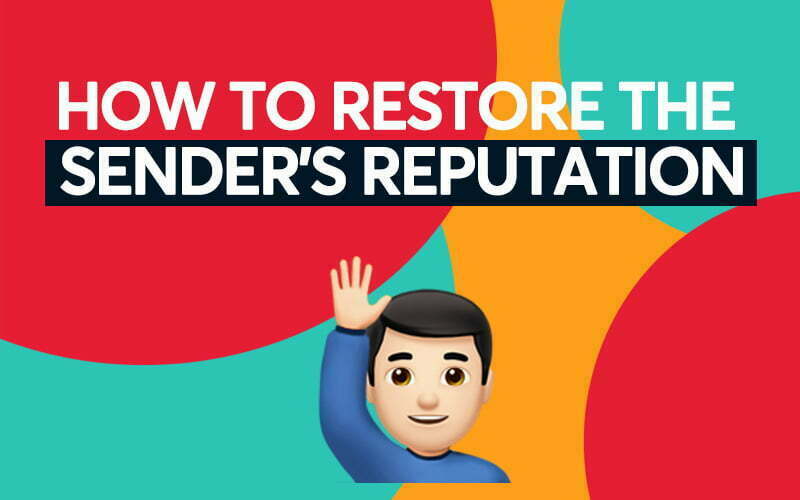Contrary to popular belief, internet users don’t hate email marketing. Moreover, email remains the most preferred channel for interacting with brands.
According to the study published by Bluecore, 68% of consumers choose email for receiving brand communications, and social media platforms come only in the fifth place:
Moreover, the study also indicates that email popularity will not go anywhere in the nearest future, as it remains one of the preferred channels for 62% of Millennials and 65% of Gen-Zers.
But while consumers prefer to communicate with companies via email, brands sometimes take advantage of such trust and start spamming their subscribers. And this is not an occasional practice, especially if you look at the global spam volume of the total email traffic:
From this graph, you can see that, although the situation with spam doesn’t look as bad as it was six years ago, it still takes over 50% off the global email traffic. It indicates that many companies still continue abusing the consumers’ trust.
Such a practice can negatively impact your reputation as an email sender. And, once you’ve been flagged as a spammer, it’s quite hard to recover from it.
But it’s definitely not impossible. So, today, we’re going to take a look at a few strategies that can help you restore your sender reputation and regain the trust of your subscribers.
What is Sender Reputation?
First and foremost, let’s take a look at what sender reputation is and how it is calculated.
Every internet service provider gives all organizations that send emails a certain score. This score is sender reputation, and it has a direct impact on the deliverability of your emails.
There are several factors that impact the score of you as an email sender:
- the number of emails you’ve sent
- the number of your emails were marked as spam
- the frequency with which your emails are marked as spam
- whether your company is mentioned on different blacklists
- the bounce rate of your emails
- the number of times the subscribers opened your email and interacted with it
- the number of users who’ve unsubscribed from your emails
Some of these factors play a more important role for a particular internet service provider than others. But any of these factors can be the reason why you have a bad reputation as an email sender.
How do You Know You Have Bad Sender Reputation?
One of the ways to analyze how your emails have been performing is to look at the results of your email marketing campaigns over time.
What you need to analyze are your KPIs and the actual results you’ve got. If there is a significant drop in engagement within a selected timeframe, it might indicate that your sender reputation has decreased as well.
You can also go through the general email marketing benchmarks and check whether your open rates, click rates, hard bounce, and unsubscribe rates differ significantly from what is considered normal in your industry.
However, such an analysis can take quite some time to complete. If you want to check your sender reputation quickly, the easiest way to do it is through online resources, such as:
- Sender Score. This tool is free to use, and all you need is to subscribe and receive an email verification. Once the resource activates your account, you can browse your sender scores on each of the domains from which you’ve sent your emails.
- Google Postmaster. With this tool, you don’t need to register an account. It’s enough to enter your domain name and verify your ownership. Once your verification is confirmed, you can check your sender score on Gmail.
- Microsoft SNDS. Similar to Google’s tool, this one helps you check your sender score on Microsoft’s native email system, Outlook. All you need to do is to log in with your Microsoft account and request access to the IPs. After going through the authorization process, you can track your sender scores within a given timeframe.
Unfortunately, none of these tools will show you the reason why your sender score dropped. Thus, if you want a fuller picture, it’s better to involve both the manual check and these tools in the investigation.
You Have Bad Sender Reputation. What Now?
Even if you’ve found out that you have a low sender score, it’s not the reason to panic. There are some things you still can do to break the vicious circle and restore your sender reputation.
Let’s take a look.
1. Authenticate Sender Verification Parameters
We’ve already mentioned that internet service providers test every email sender through an authentication system. This system consists of three main components. Let’s explore them one by one to better understand what goes behind the sender authentication process.
1) Sender Policy Framework
SPF is a protocol that helps an internet service provider to understand where the email is coming from and whether the sender of this email is not a spammer.
Basically, this is the list of the authenticated IP addresses within one domain. With this list, internet service providers can differentiate a real domain from a fake one.
What can you do with it?
By setting up the SPF, you tell the internet service provider which IP addresses are allowed to send emails on your behalf. Here are a few simple steps you can follow to build your SPF record:
- Identify all IP addresses. Collect all the addresses from which you send your emails. These addresses may include your web and in-office mail servers, the mail server used by your internet provider, the mail servers of your subscribers, and other addresses from which you send your emails. If your company uses several domains, include them in the list as well.
- Create your SPF record. Add each of the IP addresses under the v=spf1 tag. If you have any third-party IPs or domains, you should add them here as well. Once all the addresses are added, end your command with the –all tag.
- Insert your SPF record into the domain name system (DNS). At this point, you need to contact your DNS administrator, who will publish your SPF record to DNS. After that, test your emails from each of the IP addresses and domains from your record.
Note: your SPF record cannot be longer than 255 characters. Besides, it shouldn’t contain more than 10 statements, or the authentication process may fail.
2) Domain Keys Identified Mail
DKIM is the digital signature that associates your domain name with your emails. This system creates a string of characters when you sign your email that helps recognize you as a verified sender. If this string of characters has not been changed, then your email will pass the spam filters.
To create your DKIM record, you also need to create a list of all your IP addresses and domains. After that, you need to:
- Install DKIM on your email server. It will help sign all outgoing emails with a digital signature generated by the system.
- Create public and private DKIM keys. You can do it using DKIM key wizards like Dynu Systems or DKIMCore. After that, insert the keys where your DKIM package specifies.
- Configure the email server. Ask the server provider to install and verify the DKIM.
Note: it’s better to use SPF and DKIM together if you want to ensure a higher level of protection. If you’re having trouble installing both protocols yourself, your hosting provider can do it for you.
3) Transport Layer Security
This protocol encrypts the communication and authenticates the parties that communicate via an email. Basically, it will tell the internet service provider that both you and your subscribers are trustworthy.
To have this protocol, you need to install the TLS certificate on your origin server and then notify your internet service provider that the authenticity of your domains has been verified.
What’s the conclusion here?
Before you do anything else to try and restore your sender reputation, make sure you fix the technical issues. Your goal is to have your internet service provider recognize you as a verified sender, so work on optimizing these protocols first.
2. Check Your Email Content for Spam Triggers
Sending address is the first spam trigger that you need to take into account, which you can fix by implementing the security protocols we mentioned in the previous section.
However, if you’ve done that and the problem still persists, there might be other spam triggers that you have skipped, and all of them are connected to email content, including images, links, etc.
Particular words and phrases can also be spam triggers. Let’s take a look at the following email:
This email was marked as spam because its subject line is phrased in a misleading way and sounds more like clickbait.
Some other words and phrases can also trigger spam filters. Here are a few examples:
- sign up for free today
- see it for yourself
- free money
- free membership
- free trial
- certified
- congratulations
- risk-free
- call now
- apply now
- now only
- limited-time offer
- special promotion
- urgent
- take action now
These words and phrases don’t always indicate that an email is spam, but they increase the chances that it will end up in the spam folder, especially when paired with suspicious images or links.
You can avoid being flagged as a spammer by simply rephrasing your emails. And, if you’re having a hard time coming up with writing ideas, you can use the services where students usually proofread a research paper or an essay. Such services as TopEssayWriting and TrustMyPaper have professional writers who can assist you with writing, editing, and proofreading your email content and help you avoid spammy words and phrases.
Speaking about spam filters, they can also be triggered by the excessive use of emoji in the subject and the body of your email.
It doesn’t mean that you should avoid emoji in your emails by all means if you want to restore the sender’s reputation. However, there are cases when the subject line alone consists only of emoji. In this case, an email provider has a hard time deciphering the meaning of the email and ends up flagging it as spam.
So, if you want to use emojis in your emails, make sure they complement the content and don’t overcrowd it or distort its meaning. This email from Google Maps using an icon of the globe is a great example of how to use emoji in a natural way:
However, when it comes to the body of the email, try to use fewer icons and emojis because they can make your email look spammy. If you want to create a certain mood with your email, try to focus on its design instead.
3. Personalize Your Emails
The tip can hardly do anything to convince the internet service provider that you are not a spammer, but it will convince your customers from unsubscribing, and, as we already know, the unsubscribe rates play an important role in scoring your sender reputation.
There are different techniques you can employ to personalize your emails. Let’s take a look at them.
1) Audience segmentation
This is one of the most widespread ways to send more personalized emails and target a specific part of your audience with special offers.
There are different criteria according to which you can segment your list of subscribers. Here are some of the options:
- age
- gender
- location
- behavior analysis
- content preferences
Below is the example of an email that uses gender-based audience segmentation:
Audience segmentation helps you generate emails with highly personalized offers. As a result, it will be easier for you to regain the trust of your subscribers because you will only supply them with relevant deals.
2) Personalized content
You can also start rebuilding a relationship with your subscribers by sending special offers that would fit their preferences.
For instance, this personalized email from Yahoo provides coupons generated specifically for a particular person and their needs:
This is a great way to give your subscribers special treatment, as they receive something of high value for them and can benefit from. To create more personalized content, track your audience’s behavior and past purchase patterns to generate special offers.
3) Introduce yourself
Another way to reduce the unsubscribe rate and restore your sender reputation is to humanize your emails by introducing yourself in the subject line.
Reportedly, emails with personalized subject lines are 26% more likely to be opened, and putting your name in the subject line immediately turns a simple newsletter mail-out into a real-life conversation.
You can add only your name to the subject line:
Or, you can mention your brand alongside your name:
For even more personalization, you can also add the name of the recipient. This trick has been around forever, but it is still quite effective in attracting the attention of email subscribers.
Wrapping Up
Sender reputation is a very fragile thing – once it gets damaged, it’s very hard to restore it.
However, if you find your IPs and domains in the blacklist of spammers, don’t panic, you can still redeem yourself.
Start by working on implementing security protocols, including SPF, DKIM, and TLS. Once you do that, it will help you convince your internet service provider that you’re not following any spammy practices.
After that, you can start working on regaining the trust of your subscribers. When writing your emails, check them for spam triggers, such as broken links, images, and some words and phrases.
And, most importantly, work hard on personalizing your emails. The email unsubscribe rate has a significant impact on your sender score, and the only way to avoid it is to create highly targeted emails.
These three techniques can significantly improve your sender reputation over time and bring you back the loyalty of your subscribers and the trust of email service providers.







 BONUS:
BONUS: The Challenge: Join this free course and I guarantee that after 5 days you will have the necessary skills to start generating B2B clients Growth Hacking and Prospecting techniques.
The Challenge: Join this free course and I guarantee that after 5 days you will have the necessary skills to start generating B2B clients Growth Hacking and Prospecting techniques.